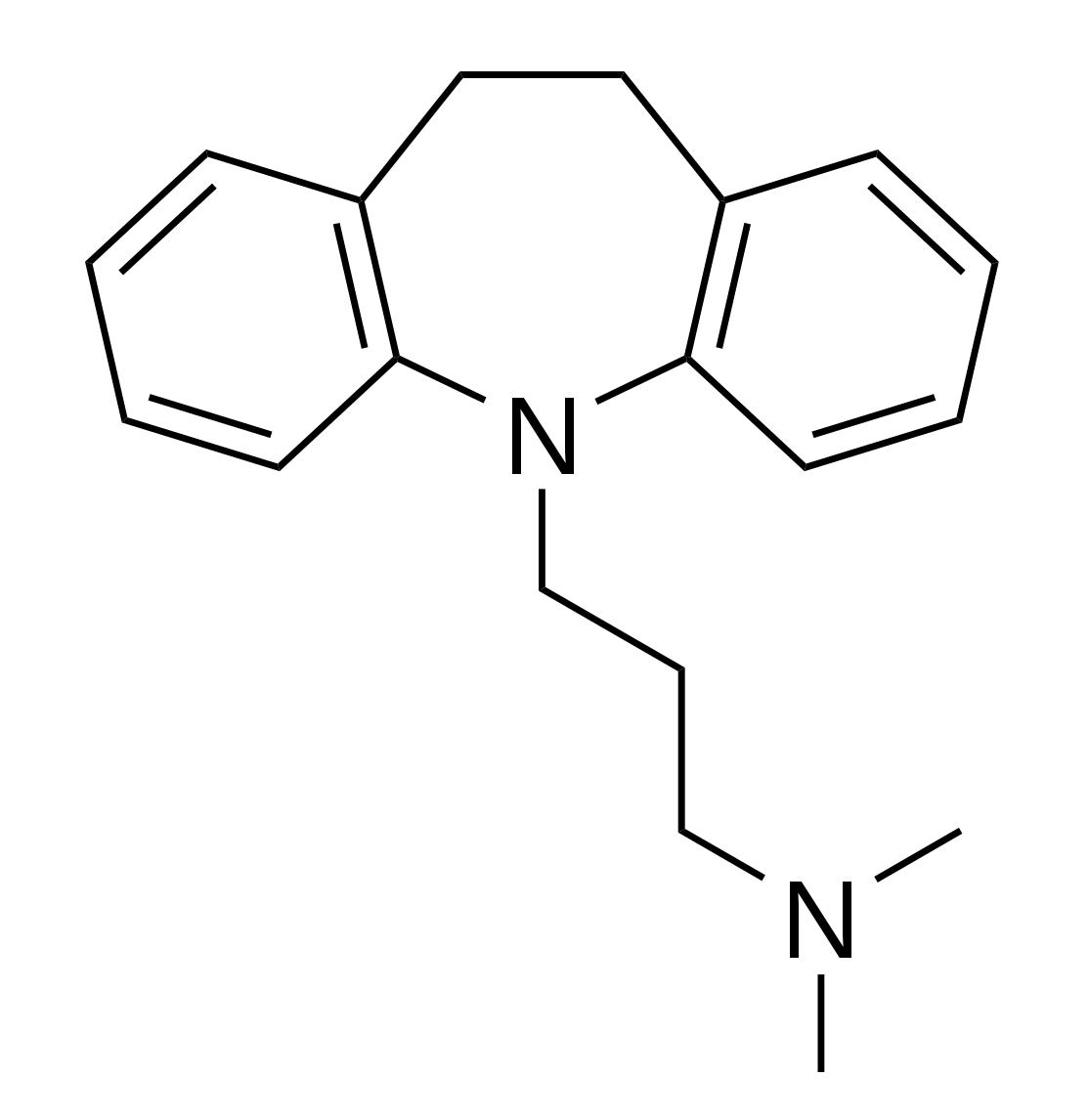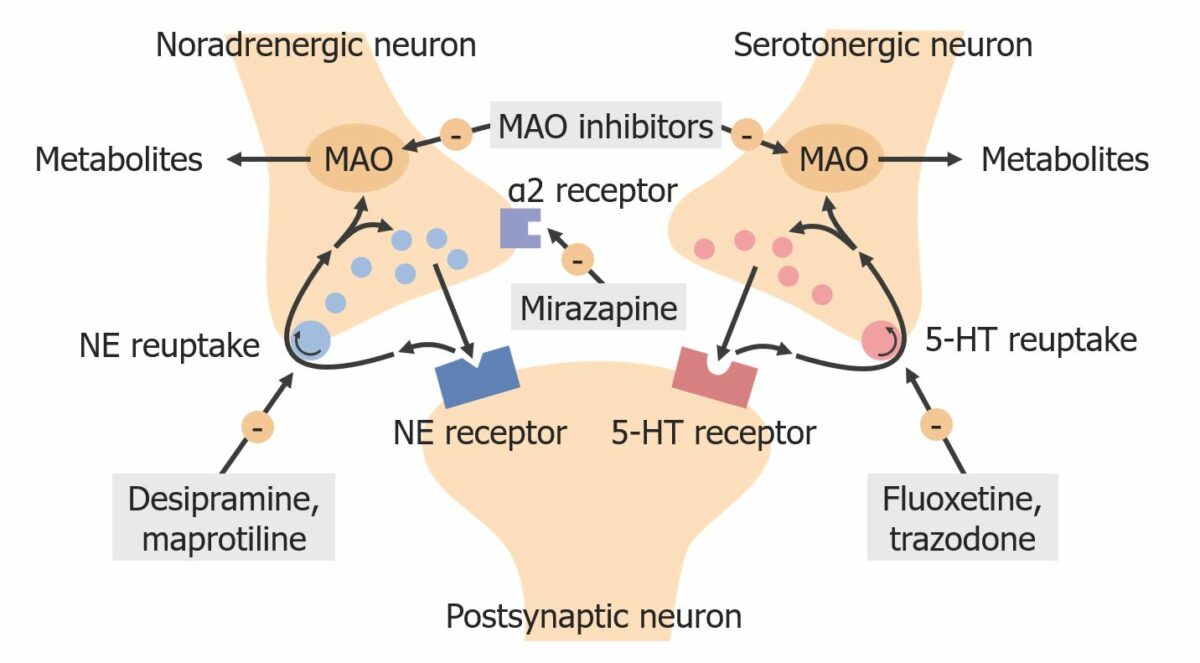Tricyclic antidepressants (TCAs) are a class of medications used in the management of mood disorders, primarily depression. These agents, named after their 3-ring chemical structure, act via reuptake inhibition of neurotransmitters (particularly norepinephrine Norepinephrine Precursor of epinephrine that is secreted by the adrenal medulla and is a widespread central and autonomic neurotransmitter. Norepinephrine is the principal transmitter of most postganglionic sympathetic fibers, and of the diffuse projection system in the brain that arises from the locus ceruleus. Receptors and Neurotransmitters of the CNS and serotonin Serotonin A biochemical messenger and regulator, synthesized from the essential amino acid l-tryptophan. In humans it is found primarily in the central nervous system, gastrointestinal tract, and blood platelets. Serotonin mediates several important physiological functions including neurotransmission, gastrointestinal motility, hemostasis, and cardiovascular integrity. Receptors and Neurotransmitters of the CNS) in the brain Brain The part of central nervous system that is contained within the skull (cranium). Arising from the neural tube, the embryonic brain is comprised of three major parts including prosencephalon (the forebrain); mesencephalon (the midbrain); and rhombencephalon (the hindbrain). The developed brain consists of cerebrum; cerebellum; and other structures in the brain stem. Nervous System: Anatomy, Structure, and Classification. In effect, there is an increased concentration of neurotransmitters in the synapse Synapse The junction between 2 neurons is called a synapse. The synapse allows a neuron to pass an electrical or chemical signal to another neuron or target effector cell. Synapses and Neurotransmission. Histaminic, muscarinic, and adrenergic receptors Receptors Receptors are proteins located either on the surface of or within a cell that can bind to signaling molecules known as ligands (e.g., hormones) and cause some type of response within the cell. Receptors are also blocked, leading to a wide array of side effects. For decades, TCAs have been utilized for depression and are considered alternative antidepressant Antidepressant Antidepressants encompass several drug classes and are used to treat individuals with depression, anxiety, and psychiatric conditions, as well as those with chronic pain and symptoms of menopause. Antidepressants include selective serotonin reuptake inhibitors (SSRIs), serotonin-norepinephrine reuptake inhibitors (SNRIs), and many other drugs in a class of their own. Serotonin Reuptake Inhibitors and Similar Antidepressants options to selective serotonin reuptake inhibitors Selective Serotonin Reuptake Inhibitors Serotonin Reuptake Inhibitors and Similar Antidepressants ( SSRIs SSRIs Serotonin Reuptake Inhibitors and Similar Antidepressants). Full effects take a latent period Latent period The time between onset of the AP and onset of the muscle contraction (i.e., the twitch) Skeletal Muscle Contraction of around 2–3 weeks. Overdose can lead to cardiac toxicity Toxicity Dosage Calculation, seizures Seizures A seizure is abnormal electrical activity of the neurons in the cerebral cortex that can manifest in numerous ways depending on the region of the brain affected. Seizures consist of a sudden imbalance that occurs between the excitatory and inhibitory signals in cortical neurons, creating a net excitation. The 2 major classes of seizures are focal and generalized. Seizures, and coma Coma Coma is defined as a deep state of unarousable unresponsiveness, characterized by a score of 3 points on the GCS. A comatose state can be caused by a multitude of conditions, making the precise epidemiology and prognosis of coma difficult to determine. Coma. Other uses include treatment for anxiety Anxiety Feelings or emotions of dread, apprehension, and impending disaster but not disabling as with anxiety disorders. Generalized Anxiety Disorder disorders, chronic pain syndrome Chronic Pain Syndrome Fibromyalgia, and nocturnal enuresis Nocturnal enuresis Involuntary discharge of urine during sleep at night after expected age of completed development of urinary control. Elimination Disorders.
Last updated: Aug 5, 2022

Chemical structure of imipramine, the 1st tricyclic antidepressant (TCA)
Image: “2D structure of TCA imipramine (Tofranil)” by Harbin. License: Public Domain
Mechanisms of antidepressants:
Top center: Monoamine oxidase inhibitors (MAOIs) inhibit the activity of monoamine oxidase (MAO), thereby increasing the number of monoamine neurotransmitters (particularly serotonin, norepinephrine, and dopamine). Mirtazapine, an alpha-2 adrenergic antagonist, results in increased release of norepinephrine and serotonin.
Right: The selective serotonin reuptake inhibitor (SSRI), fluoxetine, inhibits CNS serotonin or 5-hydroxytryptamine (5-HT) reuptake. Trazodone is a serotonin antagonist and reuptake inhibitor (SARI).
Left: Desipramine, a secondary amine tricyclic antidepressant (TCA), and maprotiline, a heterocyclic antidepressant, have potency of inhibiting reuptake of norepinephrine.
With a narrow therapeutic index Therapeutic Index An indicator of the benefits and risks of treatment. Dosage Calculation and capability to block multiple neurotransmitter receptors Receptors Receptors are proteins located either on the surface of or within a cell that can bind to signaling molecules known as ligands (e.g., hormones) and cause some type of response within the cell. Receptors, TCAs are associated with multiple side effects (e.g., cardiac, anticholinergic Anticholinergic Anticholinergic drugs block the effect of the neurotransmitter acetylcholine at the muscarinic receptors in the central and peripheral nervous systems. Anticholinergic agents inhibit the parasympathetic nervous system, resulting in effects on the smooth muscle in the respiratory tract, vascular system, urinary tract, GI tract, and pupils of the eyes. Anticholinergic Drugs).
| Medication | Characteristics | Indications | Adverse effects |
|---|---|---|---|
| Amitriptyline |
|
|
|
| Amoxapine |
|
MDD | Well tolerated in relation to other medications |
| Clomipramine |
|
Obsessive compulsive disorder |
|
| Desipramine |
|
MDD | Less anticholinergic Anticholinergic Anticholinergic drugs block the effect of the neurotransmitter acetylcholine at the muscarinic receptors in the central and peripheral nervous systems. Anticholinergic agents inhibit the parasympathetic nervous system, resulting in effects on the smooth muscle in the respiratory tract, vascular system, urinary tract, GI tract, and pupils of the eyes. Anticholinergic Drugs |
| Doxepin |
|
|
|
| Imipramine |
|
|
|
| Maprotiline |
|
|
Highly sedating |
| Nortriptyline |
|
MDD | Well tolerated in relation to other medications |
| Protriptyline |
|
MDD | Well tolerated in relation to other medications |